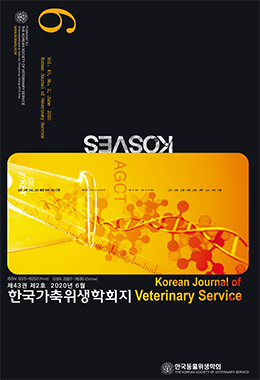The aim of this study was to investigate the prevalence of CTX-M β-lactamase and plasmid-mediated quinolone resistance (PMQR) genes, and the pattern of antibiotic resistance in cefotaxime-resistant gramnegative bacteria. A total 126 gram-negative bacteria were isolated from hospitalized dogs and cats between 2018 and 2019. The most predominant isolates were E. coli (n=41), followed by Pseudomonas aeruginosa (n=25), Proteus mirabilis (n=14), Klebsiella pneumoniae (n=9), Sphingomonas paucimobilis (n=7), and Enterobacter cloacae and Serratia marcescens (respectively, n=5). Cefotaxime-resistant isolates were identified in 26.2% (33 isolates) of 126 gram-negative bacteria. CTX-M type β-lactamase were found in 15 isolates (10 E. coli, 1 Ent, cloacae and 4 K. pneumoniae, respectively). Among the CTX-M producing gram-negative bacteria, CTX-M-1 and CTX-M-9 were detected in 10 (66.7%) and 5 (33.3%) isolates, respectively. While, CTX-M-2 and CTX-M-8 were not found. PMQR genes were detected in 12 (36.4%) isolates (4 E. coli, 2 Ent, cloacae and 6 K. pneumoniae, respectively), and the predominant PMQR gene was aac(6’)-lb-cr (n=9), followed by qnrB (n=8) and qnrS (n=1) alone or in combination. qnrA and qepA were not found. Additionally, 9 (60%) of 12 PMQR positive isolates were co-existence with CTX-M-1 or CTX-M-9. CTX-M or PMQR producing isolates showed highly resistance to penicillins (100%), cephalosporins (100∼66.7%), monobactams (72.2%), and non-β-lactam antibiotics (94.4∼61.1%) such as quinolones, trimethoprim/sulfamethoxazole, tetracycline and gentamicin. These findings showed CTX-M-1, CTX-M-9, aac(6’)-lb-cr and qnrB were highly prevalent in cefotaxime-resistant Enterobacteriaceae isolates from companion animals in our region. Moreover, PMQR genes were closely associated with CTXM type β-lactamase.




